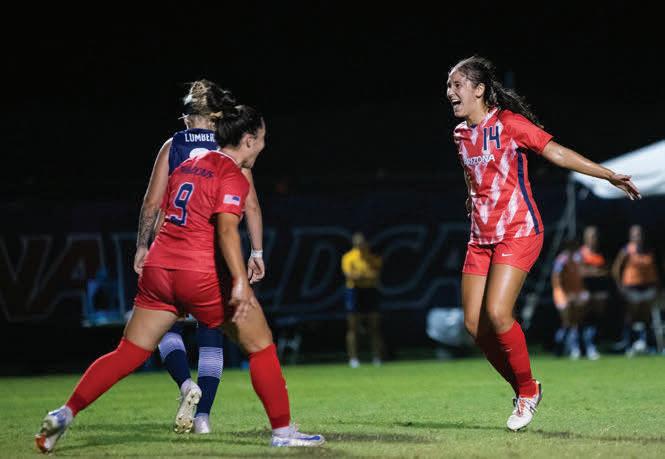












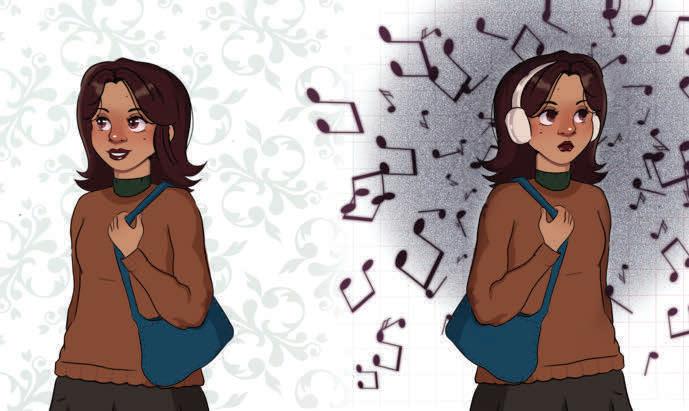

Editors-in-Chief
Sam Parker Noor Haghighi editor@dailywildcat.com
News Editors
Sophia Hammer Kanishka Chinnaraj news@dailywildcat.com
Opinions Editor
Luke Lawson opinion@dailywildcat. com
Sports Editors Nate Stenchever sports@dailywildcat.com
Arts & Life Editors Sierra Blaser arts@dailywildcat.com
Photo/Multimedia Editor Gracie Kayko Jay Corella photo@dailywildcat.com
Copy Chiefs Ari Keating Olivia Volland copy@dailywildcat.com
Comics Editor Sela Margalit smargalit@dailywildcat. com Social

Mariana

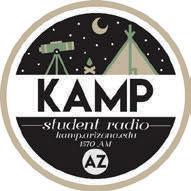
Transitions are never easy. High school to college; summer to fall; reporter to editor. It’s now Sam and I’s turn in the big girl chair as chief editors and we’re hoping to keep you informed throughout all the changes you may be going through yourself. Remember that no matter how hard things may be, you are not alone in this daunting experience we call college. I’ve spent the last two years at the Daily Wildcat , first as an opinion writer and photographer, then as a photo editor. I barely knew what I was doing when I got started, but I’ve learned so much from my peers and I feel excited to take on this semester’s challenges and triumphs. It’s been a joy to get to know our campus and greater Tucson community through journalism and as my senior year flies by, I’ll be savoring the time I have left here with a commitment to making our newsroom stronger. We really have an outstanding staff that is dedicated to this campus and I believe our content is only going to get better from here. I hope
you enjoy this team’s contributions and feel inspired to take action in whatever way feels right to you.
Iam thrilled to have the opportunity to serve as an Editorin-Chief of the Daily Wildcat alongside the incredibly talented Noor Haghighi.

I have worked at the Wildcat for the past three years, and I am grateful for the gift of spending my senior year at the UA with the same organization that helped me find my footing as a freshman. I have learned so much from the amazing people that have come through these doors, and I can’t properly express how appreciative I am of all these important lessons.
I hope this print edition finds you well, whether you’re returning to school for your senior year or just beginning as a freshman (or anywhere in between). Remember that there is a space for you at the UA, and that there are people and systems in place to support you as you navigate all the changes that come with attending college. I was lucky enough to find a great community at the Wildcat, and built such strong bonds with the people around me that little freshman Sam might never have thought possible. Enough will all that sap- thank you for taking the time to read this; the amazing
reporters on our staff poured their hearts into this work and I couldn’t be happier to work with such a driven and creative team.

As we kick off a new school year, I want to extend a warm and enthusiastic welcome to each of you. Whether you’re returning or joining us for the first time, we are thrilled to have you as part of our Wildcat community. My name is Adriana Grijalva, and I am honored to serve as your ASUA Student Body President for the 2024-2025 academic year. I’m a third-year Political Science student at The University of Arizona. Navigating university life with a learning disability has presented its challenges, but it has also fueled my passion for advocating for change. I am dedicated to being a voice for all students, striving to make our university a more inclusive and supportive environment. I am excited
to work with each of you and to make a positive impact during my term. Together, we can achieve great things.
At Associated Students of the University of Arizona (ASUA), we serve as the student government with a mission to enhance your university experience through engaging programs, impactful policies, and memorable events. We are here to amplify YOUR voice, provide opportunities for involvement, and create a campus environment where everyone can thrive, feel safe, and be successful.
As you settle into the new year, I encourage you to get involved, make new connections, and take full advantage of the opportunities available to you here at The University of Arizona. This is your chance to make lifelong friends, discover new passions, and create lasting memories. College is more than just a place to
study—it’s your home for the next four years, a chapter in your life where each page represents a new beginning. Embrace this time by getting involved, enjoying our beautiful campus, and pursuing what you love.
Remember, it’s okay to seek support when you need it. Your journey is unique, and we’re here to help you navigate it. ASUA Student Government is always available to assist you and ensure you make the most of your college experience. Here’s to change, growth, prosperity, and the future of our campus. Viva Los Gatos & Bear Down!
Warm
regards,
Adriana Grijalva Student Body President

BY KANISHKA CHINNARAJ
With a unanimous vote, the Arizona Board of Regents appointed Suresh Garimella as the 23rd president of the University of Arizona on Friday, Aug. 9.
“Throughout my career, I think you will see I have had one mission as my primary driving force and that is to serve our students. Students are the heartbeat of any university and if their success were not our North Star then we wouldn’t be a university,” Garimella said. “We owe it to the students and student body.”
Garimella received his Ph.D. from the University of California, Berkeley, his master’s degree from The Ohio State University and his
bachelor’s degree from the Indian Institute of Technology, Madras in mechanical engineering.
Prior to coming to Tucson, Garimella was the 27th president of the University of Vermont and served as the executive vice president for research and partnerships at Purdue University. During his time at Vermont, Garimella grew the UVM’s enrollment of both undergraduate and graduate students, doubled the university’s research enterprise and focused on mentoring students through leading an undergraduate seminar class in civil discourse.
Over the course of five months, an 18 member presidential search committee gathered to vet prospects, looking for someone who possessed the qualities and

experience to be the leader of Arizona’s land grant institution.
“How can you beat a sitting president at another land grant university who is also in the National Academy,” said Joellen Russell, a distinguished professor in the UA College of Geosciences and a member of the search committee.
Garimella and the search committee members spoke at a press conference at the Student Union Memorial Center on Friday. The questions focused on two main areas of community interest: the financial crisis that the University of Arizona is currently facing and the divide within the community due to Palestine and Israel conflicts.
Garimella said his past experiences at Vermont and Purdue equipped him to address the financial situation at the UA.
“I have a lot of experience in working within financial constraints in higher education. In the University of Vermont we were very tuition dependent and yet we froze tuition for five years. We did that at Purdue before for twelve years,” Garimella said. “And yet we invested in all the right things and were able to move forward. It is a question of looking at your expenses carefully and trying to diversify your revenue.”
Garimella also fielded questions concerning antisemitism on college campuses and student protests

in support of Palestine.
“[With] anti-semtisim, Islamophobia, [the] Israel-Gaza conflict, it is truly a complex and challenging time. The answer to this is not to go more into our corners but to come together and to be able to talk across differences and have the courage to express and listen to others’ views,” Garimella said.
Garimella taught a class on civil discourse while at the University of Vermont and he had students essentially “take some difficult topics, do some reading on them and under Chatham house rule discuss these things.”
Garimella said that this type
of communication, which he has experience facilitating, will be an important tool in continued conversations about these conflicts.
“We equip each other, ourselves, one another to honestly express opinions without being demonized for something. I do think the nation needs healing, the campus community needs healing from many things, and we all need to get better at speaking with each other,” Garimella said.
ABOR is currently working on finalizing Garimella’s contract and selecting a start date. Until then, Robbins will remain in his role as university president.


BY GRACE GARFOOT
The Daily Wildcat
With the return of students to campus this August, the University of Arizona chose to increase the presence of security on campus in the hopes of creating a more secure environment for their students.
These measures include the addition of new blue light emergency phones, attached security cameras on certain blue lights located in busier areas, such as the mall and the University Boulevard campus gates and naloxone kits located in specific locations on campus.
“Every year we have new students coming onto our campus. It is therefore important that people coming onto campus know what resources are available and what to do in the event of an emergency,” Chief Safety Officer Steve Patterson said.
According to Patterson, the UA Office of Public Safety added a new layer to the interactive UA Public Map designed to help students,
faculty, staff and visitors navigate campus, classrooms and parking, while also providing important health and safety information. The locations of this new layer include:
1. Automated External Defibrillators (AED)
2. Stop the Bleed kits
3. Naloxone kits for rapidly reversing an opioid overdose
4. Blue light emergency phones
5. Building evacuation plans
“It’s not enough to talk about safety resources. Knowing where safety resources are before an emergency happens can be life-saving,” Patterson said.
The reason for these new additions remains unclear; the only reasoning that Patterson gave was: “Campus safety is a never-ending charge.
The Office of Public Safety is always looking to improve safety for our community.”
According to Patterson, all students are also encouraged to complete the Threat Assessment and Management Training and other important trainings, which can be found at safety.arizona.edu.
“Over the summer, the director
“It’s not enough to talk about safety resources. Knowing where safety resources are before an emergency happens can be life- saving,” Patterson said.
of the Threat Assessment and Management Team (TAMT) Dr. Jessie Semmann developed this training to help our community understand targeted violence,” Patterson said. This training includes identifying warning behaviors and can be a valuable resource to help students, faculty and staff prevent and mitigate risk and address their safety concerns.
Additionally, Patterson reminds students that knowing what to do in an emergency is important and to take recommended steps to safeguard, such as:
1. Avoid walking alone after dark.
2. Use alternate transportation such as the Parking & Transportation Services Night Cat, ASUA SafeRide, taxis or ride-hailing services like Uber and Lyft.
3. Call UAPD at 520-621-8273. When available, UAPD may provide a walking or driving escort to your on-campus location or vehicle.
4. Walk in well-lit areas.
5. Know where you are going and familiarize yourself with alternate routes in case you must change your direction to avoid potentially unsafe or uncomfortable situations. If you change direction, go toward populated areas for safety.
6. Use one of the university’s 300-plus emergency blue light 911 phones located across campus and in classrooms and elevators. The phones automatically share their

location and are directly connected to UAPD.
7. University students, faculty and staff can download the LiveSafe app for free, realtime assistance, such as connecting to 911, ASUA SafeRide or a map to help navigate on campus.
BY EMMA LAPOINTE
Most of the pressure and attention of this year’s election cycle will be on the presidential campaign and its impact and results. However, local elections in Arizona and Pima County affect University of Arizona students and their future as well.
Voters might overlook ballot measures when headed to the polls. While not a comprehensive list, the following are some key measures that will appear on the ballot for Arizonans in November.
Proposition 139: “Establish a state constitutional right to abortion.”
A “yes” vote would add the right to an abortion to the Arizona constitution.
A “no” vote would keep the Arizona constitution as it is and not add the right to an abortion to the official state constitution.
This proposition represents a hot-button issue in Arizona politics and nationwide. Following a 2022 Supreme Court ruling that left the decision on abortion rights to the states, in May, Arizona tried to revert back to a Civil War-era abortion law. States all over the U.S. have proposed similar propositions.
Proposition 136: “[Provides] for challenges to an initiative measure or constitutional amendment after the filing of the measure with the secretary of state.”
Proposition 136 would allow voters to challenge the constitutionality of a proposed initiative in court up to 100 days before an election. Under current Arizona law, individuals can only challenge the constitutionality of an initiative after the initiative has
become law.
Supporters argue the proposition gives voters more say and ensures constitutional ballot measures, while opponents worry about chaos and increased costs.
Proposition 138: Allows “for tipped workers to be paid 25% less per hour than the minimum wage if any tips received by the employee were not less than the minimum wage plus $2 for all hours worked.”
The current Arizona law regarding tipped workers mandates an hourly wage of $11.35, which is $3 less than the current state minimum wage, as long as their take-home pay, with tips included, equaled the minimum wage.
The proposition would have workers paid $10.77, as long as their tips equal minimum wage plus $2 for every hour worked.
The argument for this proposition is that it will help smaller businesses that do not have the means to pay their workers minimum wage.
The argument against this proposition is that restaurants that want to stay alive should be able to pay their workers fairly and not have workers depend on tips.
Proposition 314: “[Allows] for state and local police to arrest noncitizens who cross the border unlawfully, [allows] for state judges to order deportations, [requires] the use of the e-verify program for some public governmental programs and employment eligibility purposes, and [makes] the sale of fentanyl a Class 2 felony if a person knowingly sells fentanyl resulting in the death of another person.”
The proposition allows for the arrest of noncitizens due to unlawful entry, mandates using E-Verify for welfare program applications and imposes a Class 6 Felony for providing false information.
Supporters of the proposition argue that it would provide a secure border and tighten the control of illegal immigration from foreign countries.
The argument against this proposition is that it will put more pressure on law enforcement to act as federal officers, potentially hurt Arizona’s economy and that there are better ways to improve border security, such as more border patrol agents and a better asylum system.
Proposition 313: “Establish[es] a life sentence for anyone convicted of a Class 2 felony for child sex
trafficking.”
Current Arizona law states that if someone is found guilty of trafficking someone between the ages of 15-17 they can receive 10–24 years in prison. If someone is found guilty of trafficking anyone under 15 will receive a minimum of 13 years.
A “yes” vote will eliminate the current year ranges and sentence anyone charged with these crimes to a natural life sentence with no chance of release.
Opponents of this bill reference how sometimes minors are coerced by their traffickers to sex traffic
someone younger than them. People worry that these minors who are already traumatized will receive an immediate life sentence for something they had no choice in doing.
Proposition 135: “[Provides] for the legislature to terminate a state of emergency or alter the emergency powers of the governor during the state of emergency, and provide for any emergency powers granted to the governor to automatically terminate 30 days after the state of emergency is proclaimed, unless

CONTINUED FROM PAGE 8
the state legislature extends the emergency powers granted to the governor, and in except of cases for a state of war emergency or an emergency arising from a flood or a fire.”
This proposition aims to enshrine more checks on the executive branch within the Arizona state constitution. Supporters of the bill believe there are no solid checks and balances to curb the governor’s power.
People who oppose this proposition believe that if it passes, it will be much harder for Arizonans to get the benefits they need in a state of emergency, especially if Congress is not in session at the time to provide the ⅓ signatures required.
Tucson voters decide on local courts, law enforcement and school board members. These races affect Tucson’s culture and regional crime. The Tucson Unified School District School Board candidates include Pilar Acosta Ruiz, Esteban Flores, Natalie Luna Rose, Ravi Shah and Sadie Shaw. The
election allows for the selection of three candidates.
Other local Pima County races include:
Pima County Assessor:
• Suzanne Droubie (Incumbent), Dem.
Pima County Attorney:
• Laura Conover (Incumbent), Dem.
• Howard Druan, Green Party
Pima County Recorder
• Gabriella Cázares-Kelly (Incumbent), Dem.
• Dominic CampbellGonzalez, Rep.
Pima County School Superintendent
• Dustin Williams (Incumbent), Dem.
Pima County Sheriff
• Chris Nanos (Incumbent), Dem.
• Heather Lappin, Rep.
Pima County Treasurer
• Brian Johnson, Dem.
• John Ackerley, Rep. Pima County Board of Supervisors
District 5
• Adelita Grijalva (Incumbent), Dem.
According to data from Arizona voters, some of the main issues for voters across the state include:
1. Improving infrastructure
2. Enhancing education by addressing funding levels and overall teaching quality
3. Opposing cuts to education, healthcare and public safety as a means to balance the state budget
4. Enacting immigration reform
5. Increasing the availability of affordable housing.
Many of these decisions depend on local-level candidates enforcing these policies or listening to their communities before proposing or enacting legislation at the state level. For example, the TUSD School Board might listen to Tucson voters’ concerns about the level of funding for education.
Another significant issue that candidates speak about in Tucson is increased crime.
According to the Center for the Future of Arizona, Tucson voters in particular are very concerned about the state of current roads, the funding of local education programs and that Tucson voters do not feel like legislators are listening to the number of diverse voices in the Tucson community.
Arizona voters, being close to the border, are also likely to be concerned about border security.
Arizona has become a critical state on the national level in the state’s Senate race and is a target for Presidential candidates Kamala Harris and Donald Trump.
The Senate race includes Democrat Ruben Gallego and Republican Kari Lake. Lake has a history in Arizona as the former opponent of current Governor Katie Hobbs and a close ally of former President Trump.
Lake recently lost her appeals court challenge, in which she argued that Phoenix ballots had not been appropriately verified in 2022, causing her to lose the race for governor.
Gallego has been a U.S. representative for AZ District 3 since 2023. District 3 covers most of West Phoenix, including parts of Glendale. Arizona has also become a battleground state in the Presidential election. In Harris’ first rallies after announcing her campaign, she visited swing states, including Arizona.
Arizona is a “swing state,” meaning that it could be won by either presidential candidate and so each campaign focuses a large part of their resources on it. Therefore, Trump and Harris will most likely pay attention to critical issues for states like Arizona to campaign for the voters in their respective parties and win over the popular vote and the electoral college delegates.
These fundamental issues, according to a report from U.S. News, will most likely include creating hard policy stances regarding immigration, the economy and abortion following the heated debate in Arizona courts regarding abortion earlier this year.
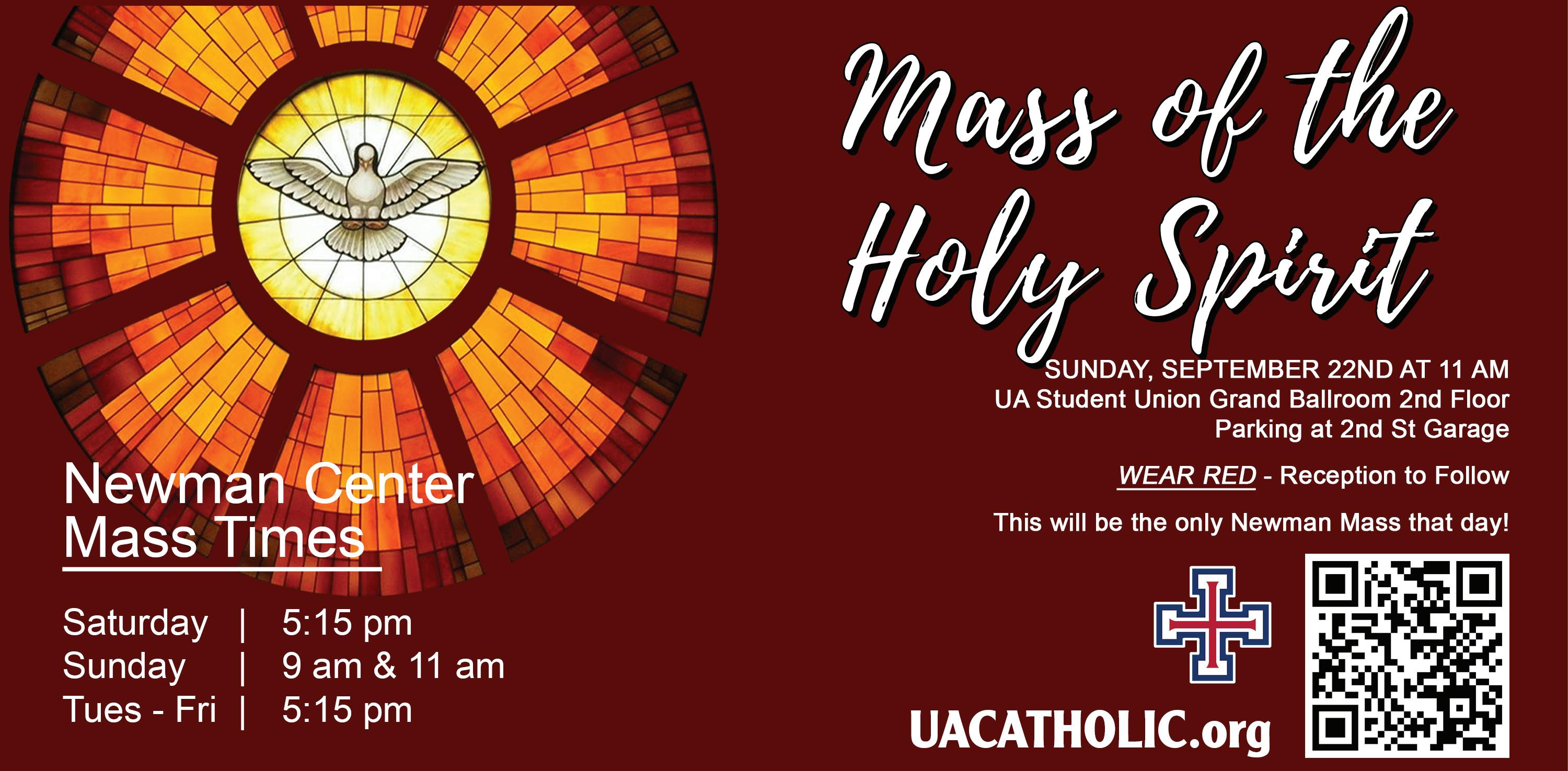
The University of Arizona bookstore has a new look after a summer remodel
BY SIERRA BLASER
Daily Wildcat
“Wow, this looks different,” will be the first thing many returning students say when they enter the University of Arizona Campus Store this fall.
The Campus Store, known as the UA Bookstore for more than 20 years, underwent a huge transformation over the summer. It is now open for students to view the renovations and shop the product expansions.
“We wanted to really represent and scream ‘university’ without saying ‘university’ right when you walk in,” said Executive Director of University Campus Stores Peter Neff. “We also wanted to make sure it was more inviting and inclusive, so students could spend more time here if they wanted.”
Neff has held an executive
position at the store for the past two and a half years. He said when he first took the job, his team did a marketing study that found that UA students no longer connected with the bookstore and instead found it out of fashion.
“They felt it was their grandparents’ store, that our products were dated; they wanted something more than red, white and blue,” Neff said.
The summer renovation changed exactly that.
Neff said the Campus Store name change better suits the entity as a whole. He said the bookstore’s name seemed to steer students away rather than bring them in to see all of the products the store has to offer.
The store now exhibits more dark blue walls spelling ‘hello’ in different languages, brighter lighting, open spaces with chairs to lounge on and expanded tech areas. According to Neff, products are also from top
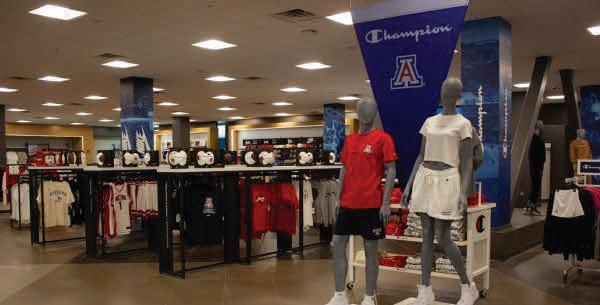
brands, such as Nike, Lululemon, Champion and Hype and Vice.
“We even took our core T-shirts, which students come to expect that have different slogans on them and found a better distributor with better quality, so that we could make sure it was just something that was overall a better experience,” Neff said.
The executive director said the response from parents, incoming freshmen and returning students has been overwhelmingly positive.
“They have been ecstatic beyond even our wildest dreams,” Neff said. “I heard earlier today a daughter asking her mother, ‘Is this what it looked like when you came here?’ And she was saying, ‘Absolutely not.’”
Iyanna Robinson, a student worker who has been at the store for about five months, said she has loved coming back this semester to see the new changes.
“It feels more open, if that makes any sense,” Robinson said. “I love the new chairs too. I feel like now people can chill, shop and do whatever else if they want to.”
Neff said one of the features he’s most proud of in the store is the wall near the checkout area displaying flags representing Arizona’s 22 tribal nations. He said he worked closely with indigenous communities on campus to ensure how to best honor the tribes.
“I think for us it’s a simple reminder to everyone who sees it, especially if it’s one of your nations up there, that this is a part of who you are,” said Senior Vice President
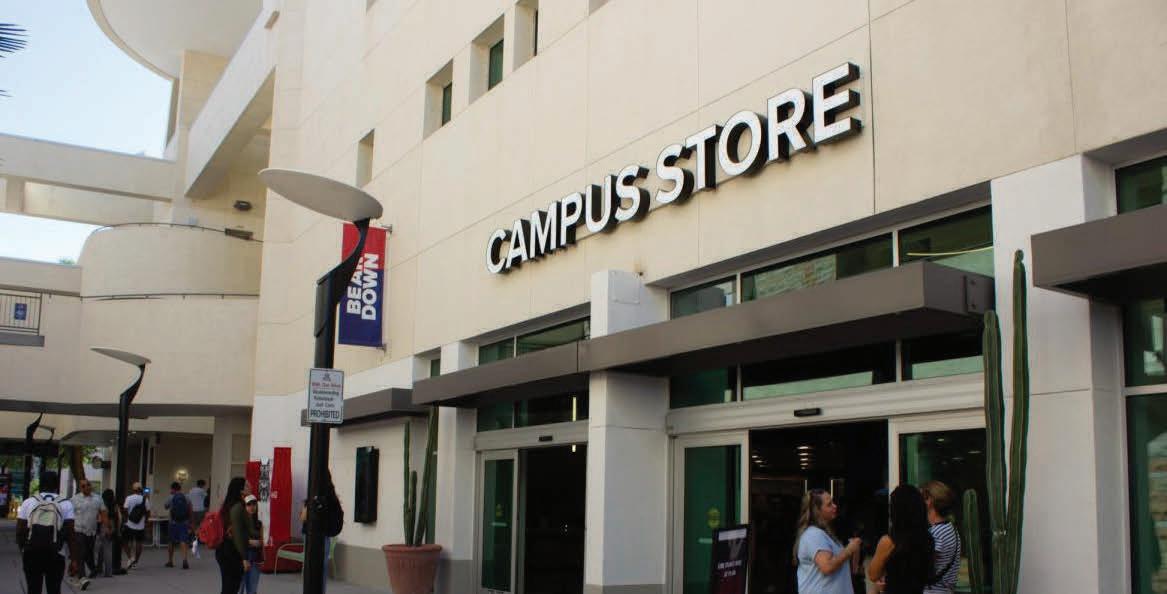
for Native American Advancement and Tribal Engagement N. Levi Esquerra. “I’ve taken people in there from different native nations or those tribes and when they see it, they’ve just got goosebumps.”
According to Esquerra, the display is beyond what he imagined and “on paper doesn’t do justice to the finished product,” Neff said.
“I mean, when I see that, it is just like wow. Those are wow moments,” Esquerra said. In addition to the tribal flags, the bottom floor now features a screen where students can tap on any country’s flag and a display will pop up including how many students attend the UA that are from that country.
“We wanted to recognize that these international students are here and let them know that there are other students here like them,” Neff said.
The store also expanded its technology service center. Resembling
a mini Apple Store, the area offers iPhone repair services in addition to battery replacements, keyboard and trackpad malfunction repairs, basic troubleshooting services and more.
While the university is still in a financial crisis, Neff said these plans were already in the works before any of these problems came to light and the Campus Store renovations were funded strictly by the profits made over the years.
“We are self funded, we take no money from the state. We are a state entity, but we are completely self funded by what we drive out of sales,” Neff said. “Last year, we gave almost $7 million back to the university. So, we made sure long before they had the financial issues that all the money had been set aside so that we could do this.”
The Campus Store, located at 1209 E. University Blvd., is open Mondays-Thursdays from 7:30 a.m.7 p.m.; hours vary Fridays-Sundays.
BY NANDINI MANEPALLI
After its successful launch last semester, the University of Arizona’s Science is Fun club is returning for the fall semester.
The club takes a unique approach to its goal of promoting inclusion in science fields by presenting science experiments — like dry ice or glow-in-the-dark (phosphorescent) paper — to kids in a fun and accessible way.
“Our goal is to show that anyone can be a scientist,” Abigail Keyes, president of Science is Fun Club, said. “We try to have diverse groups who are presenting to these younger kids and we hope to break down any socioeconomic or educational barriers that exist for younger students in their pursuit of science and education.”
Keyes started the club at the UA last semester, inspired by her experience of being a part of the original Science is Fun club at her high school.
“Seeing the joy and smiles on these kids’ faces is what really motivated me personally in continuing this club and bringing it to UA,” Keyes said. “I just love the fact that the kids love it.”
Club member Pranaya Gurrala, who was also a member of the original club, echoed similar sentiments, recalling handmade letters she received from kids after a presentation.
“In every note they were like ‘my favorite part was the Van de Graaf generator’ or ‘my favorite part was the liquid nitrogen,’” Gurrala said. “It’s one of my favorite memories and it meant a lot to read these heartfelt letters from these kids who enjoyed the experiments.”
But it’s not just kids that get pulled in by Science is Fun’s demonstrations and events.

“One of my favorite parts of the club is also seeing the adult interaction with our experiments,” club secretary Kaylee Ferreira said, recalling a Science is Fun event held during last year’s solar eclipse at the Flandrau Science Center. “There were so many adults that came up and they were so enthusiastic about it.”
“When the parents come up, I get to go more in-depth and talk about the actual scientific explanations involved and I personally get a lot of enjoyment out of that because it’s a fun conversation on different levels,” Keyes said.
In addition to offering learning
experiences for members of the Tucson community, the club also offers the chance for members to improve their collaboration and presentation skills.
Meetings include learning science experiments and practicing demonstrations or bonding activities like making bracelets for kids at the club’s events.
“Meeting people that join this club is great, because aside from just science, you do get to improve your presentation and communication skills,” Gurrala said. “Seeing people branch out of the shell they had when they first joined the club
and then blossoming into this great teaching mentor for the younger generations is one of my favorite parts.”
Looking toward the future, the club is interested in exploring collaborations with other clubs and organizations on campus.
“For example, with the Rugby team, we could do an exercise-themed or biologythemed walk-up or we could do a codingthemed walk-up with CS majors,” Keyes said.
The club also hopes to continue expanding its presence throughout the Tucson community.
“This past year, we’ve mainly focused on doing walk-ups, but my personal goal is to expand to classroom presentations starting with an elementary level and then maybe in the future we’ll expand to the high school level,” Keyes said.
“I’m also hoping to organize some more walk-ups that are off campus and go to different parts of Tucson, so that we can interact with more people in the community,” Ferreira said.
This semester, Science is Fun will be meeting every other Monday at 6 p.m. in room 318 of the Chemistry building. The club’s Instagram account, which frequently posts updates and announcements, is @uascienceisfun118. Their first meeting of the semester will be Sept. 9.
BY REED LOFSTEDT & KELLEN O’HALLORAN
Closing out an unexpected and tremendous 10-3 season, along with a massive victory over then No. 12 University of Oklahoma, the Wildcats faced postseason turmoil as head coach Jedd Fisch announced his departure to the University of Washington. This would put the program on edge, having many players enter the transfer portal and losing a majority to Fisch’s Washington.
However, the shining light during this time was the announcement that most of the team would return for the upcoming season, most noticeably Noah Fifita, Tetairoa McMillan and Jacob Manu. This would be followed by the announcement of the program’s next coach, San José State’s Brent Brennan. This also would be their first season moving from the Pac-12 Conference and into the Big 12.
History:
The Arizona Wildcats enter the season with their highest preseason ranking (21) since the 1999 season when they were ranked fourth. This position comes with pressure, as the Wildcats hope to live up to the ranking as well as build on the success within the program. The coaching trio of Brennan, Duane Akina and Dino Babers comes back once more: the three were all present at Arizona in 2000. When these coaches were last together with the Wildcats, Arizona also moved conferences for the first time since 1977 when they left the Western Athletic Conference to join the Pacific-10 Conference, which later turned into the Pac-12.
Impact Games:
The Wildcats open their first season in the Big 12 conference with some serious matchups on the road against two ranked opponents in their first two conference games of the season.

The Wildcats face No. 18 Kansas State University in Week 3 and No. 12 University of Utah in Week 4. The last time Arizona faced Kansas State was in 1978, which resulted in a 31-0 victory for Arizona. The Wildcats faced the Utes in 2023 and Arizona thrashed Utah in a 42-18 victory.
The latter games of the season pit the Wildcats against the University of Colorado in Week 7; when the teams last faced each other in 2023, Colorado lost to Arizona 34-31. Other games against the University of Central Florida, West Virginia University, Texas Christian University and Texas Tech University will be sure-fire introductions for the Wildcats as they hope to put the Big 12 on notice this season.
Impact Players:
The Wildcats will be looking toward returning stars like Noah Fifita, Tetairoa McMillan, Jacob Manu and
Tacario Davis to come back in prime form. The new additions, however, made during the transfer portal and recruitment this offseason also have plenty of shoes to fill. The two new running backs, Kedrick Reescano from the University of Mississippi and Jacory Croskey-Merritt from the University of New Mexico were some of the most sought-after players acquired from the transfer portal. Both will be looking to replace Jonah Coleman and Jordan Washington, who left this offseason to follow Jedd Fisch to the University of Washington. Reescano played sparingly on special teams as a true freshman for Ole Miss and Croskey-Merritt is looking to grow on his previous season which saw him record 1,190 yards and 17 touchdowns.
The Wildcats have also brought in some defensive help via the transfer portal in defensive lineman Tre Smith
from SJSU, defensive lineman Kevon Darton from Syracuse University and cornerback Marquis Groves-Killebrew from the University of Louisville to name a few. These newcomers look to provide for an Arizona defense that got torn apart during the transfer portal.
Preseason Power Rankings and Predictions, Kellen O’Halloran:
This is one of the most highly anticipated college football seasons in a while, mostly due to conference realignment across the country. The Big 12 lost Oklahoma and Texas, but Colorado, Arizona, Arizona State and Utah all joined the conference after the Pac-12 essentially disbanded. The Big 12 will be a deep conference this year thanks to its new additions, but it is not projected to be a conference with many national title contenders. Bet365 gives Utah the 16th best odds in the country to win the College Football Playoff, which are the highest odds for a Big 12 team. However, a Big 12 team is guaranteed a chance as the new playoff format gives all major conference champions a first round bye. Here are my 16 best teams in the Big 12 headed into Week 1. 1.University of Utah
Kyle Whittingham has orchestrated 17 winning seasons in his 19 years as head coach of the Utes, including two Rose Bowl appearances in the last three seasons. If not for injuries plaguing Utah’s roster last year including losing starting quarterback Cam Rising for the year, they would have outperformed their 8-5 2023 record. Rising is back for the season and so are other key starters. RiceEccles being one of the toughest venues to play in as an opposing team combined with Utah’s experience and quarterback play puts them at the top of my list.
CONTINUED ON PAGE 13
CONTINUED FROM PAGE 12
2. Kansas State University
Although Kansas State lost QB Will Howard, they bring in a talented roster for this season. Sophomore QB Avery Johnson brings more mobility and quickness to this offense than before.
The Wildcats have finished the season ranked inside the top 25 the past two seasons, and I expect them to continue that level of success this season.
3. University of Arizona
Arizona has arguably the best quarterback-wide receiver combination in the country in Noah Fifita and Tetairoa McMillan. However, Jedd Fisch leaving created too many holes in their roster with players departing after he left. Brent Brennan has a tough task ahead of him as a first year coach leading a team into a new conference.
4. Oklahoma State University
After finishing last season with a strong 10-4 record and falling just short in the conference championship, Mike Gundy aims to steer his team back to the top. Leading the charge is Doak Walker Award recipient Ollie Gordon II, accompanied by key returnees like veteran QB Alan Bowman, WR Brennan Presley, offensive tackle Dalton Cooper and linebackers Collin Oliver and Nick Martin who look to lead the Cowboys to a playoff berth.
5. University of West Virginia QB Garrett Greene and running backs CJ Donaldson Jr. and Jahiem White return after propelling West Virginia to a top-four national ranking in rushing yards per game. The wide receiver group is deep and the defense, especially the secondary, has been bolstered by key transfers. With these strengths, the Mountaineers have a legitimate shot at contending for the Big 12 Championship.
6. TCU
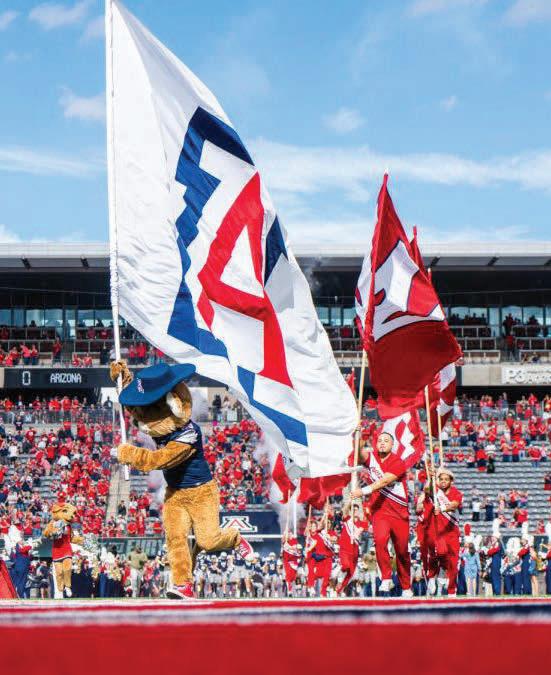
mark for the Jayhawks headed into this season. Daniels has missed 14 games in his career due to injury, so his health is a major factor in the team’s performance. Even with Daniels, it would take a lot of upsets for the Jayhawks to find themselves contending for a Big 12 title.
10. University of Central Florida
UCF has some of the best skill players in the conference, and now they have a proven QB in transfer KJ Jefferson. UCF could make some noise but their lack of depth and winning experience will halt them.
11. Texas Tech University
Texas Tech entered last season as a dark horse contender for the Big 12 title, but injuries at the QB position led to a 7-6 finish. If QB Behren Morton can stay healthy, the Red Raiders are a much better team.
12. BYU
BYU went 5-7 last year and they don’t project to be better headed into this season. The Cougars have too many question marks at key positions.
13. Baylor University
Head coach Dave Aranda is on the hot seat after a disappointing 3-9 finish in 2023. They turned to NIL in hopes of adding new talent, with a marketing campaign centered around the slogan “we pay players.”
14. University of Houston
After making the National Championship game in 2022, the Horned Frogs underperformed and finished the 2023 season with a 5-7 record. Sonny Dykes is one of the most underrated coaches in the country, and has one of the more talented rosters in the conference.
7. Iowa State University
Entering his ninth season, Matt Campbell ranks among the longesttenured coaches in the conference. The Cyclones exceeded expectations with a winning record last year and
now bring back almost all their starters on both offense and defense.
8. University of Colorado Colorado’s stars Shedeur Sanders and Travis Hunter showed out in their week 0 win, beating North Dakota State 31-26. Although Colorado has many talented players on their roster, their lack of depth, chemistry and physicality will prevent them from being real contenders in the Big 12.
9. University of Kansas
Will Jalon Daniels be able to stay healthy? That is the biggest question
Houston had a tough first season in the Big 12, despite beating West Virginia last season. Unfortunately, this season doesn’t seem much more promising for the Cougars as they are still rebuilding to compete in the Big 12.
15. University of Cincinnati
Like Houston, Cincinnati struggled in their first year playing in the Big 12. They too are in the beginning stages of a rebuild.
16. Arizona State University
Arizona State went 3-9 in the Pac12 last year, and you could argue they are returning a worse team. They will struggle in their first year playing in the Big 12.


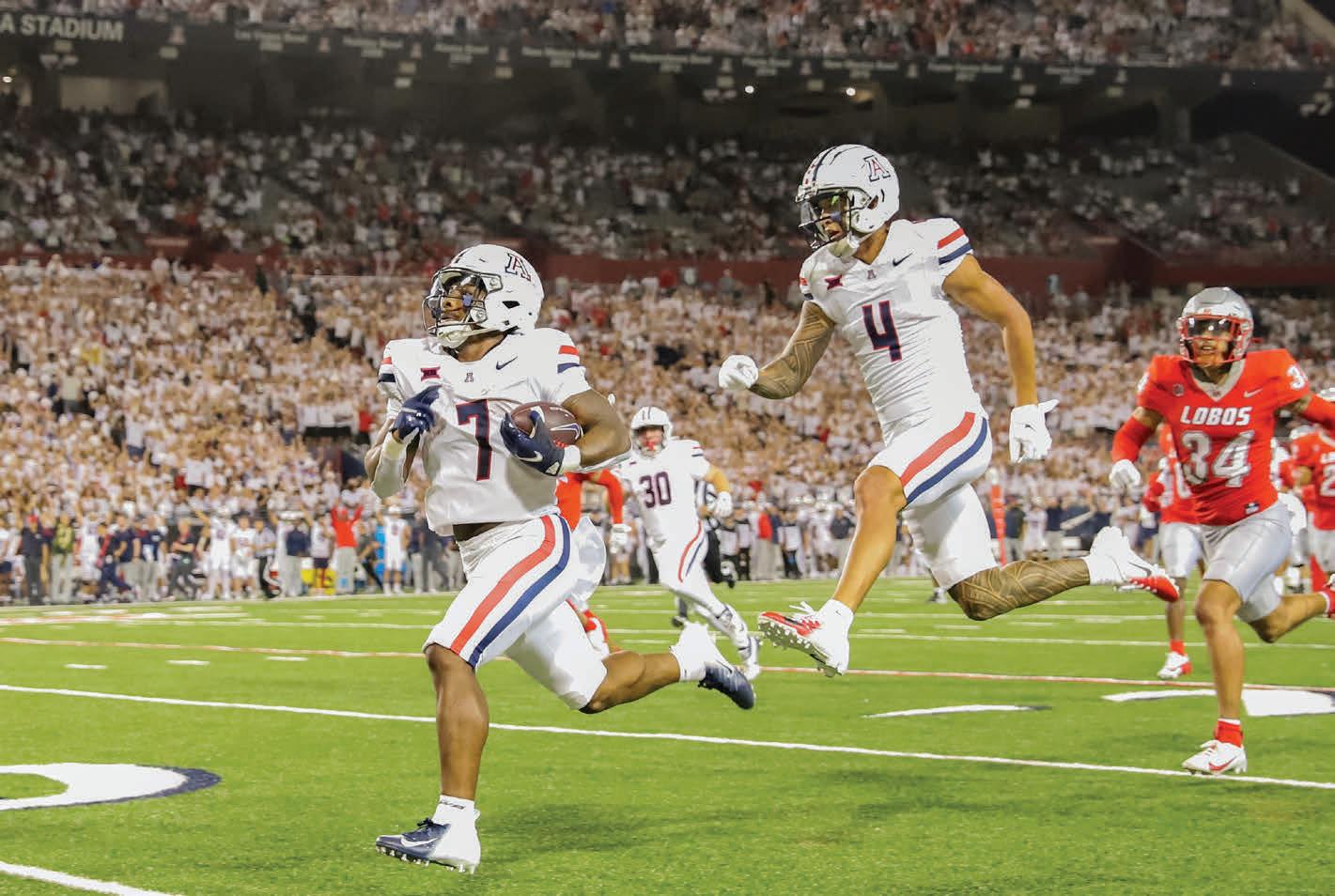
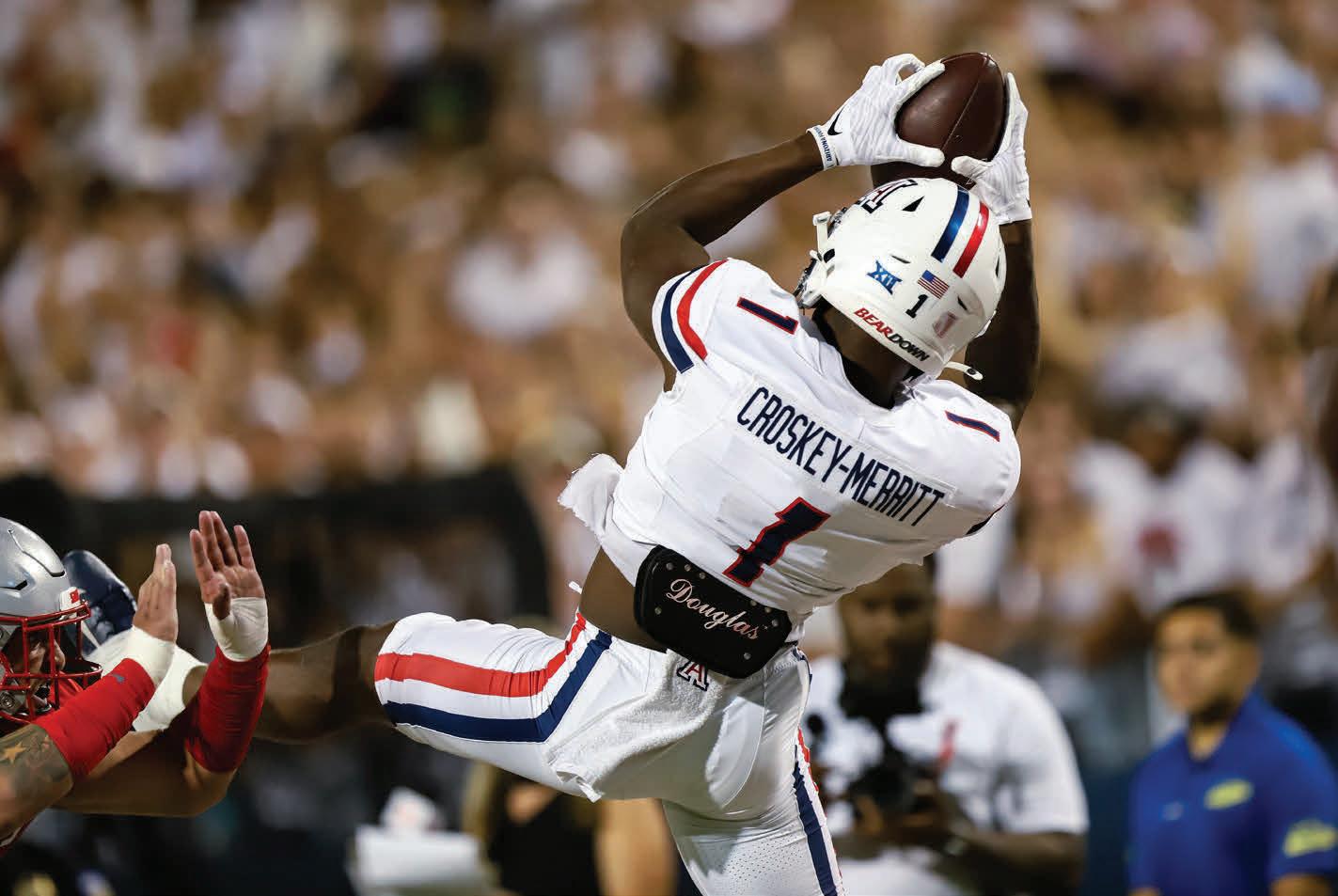






BY KATE HERRERAS-ZINMAN The Daily Wildcat
In 2022, just a month and a half after my 21st birthday, I came out of the closet as transgender. A lot has changed since I came out; I’m more confident in my self-expression — I have no problem wearing a dress and makeup in public and I no longer associate myself with my deadname in any way. But one thing has stayed absolutely the same for me since the very day I came out: I am incredibly uncomfortable using a public restroom, especially here at the University of Arizona. As the semester starts and I return to in-person classes, I can’t shake the anxiety that comes with using the restroom.
I do use a public restroom when I really have to, and it’s the women’s restroom that I use, but I’ve never once been comfortable inside of one. I do not pass as cisgender in any way, meaning no one would think I was assigned female at birth by looking at
me, and I hate the idea of feeding the “man in a dress” discourse just by using the restroom. If any cis woman is in there, I immediately feel like I’m being judged, and the worst part is, I’m worried I might scare somebody by using the restroom. However, I don’t want to use the men’s restroom either. Not only does using a men’s restroom make me feel gross (it’s a feeling I can only describe as “I’m not supposed to be in here”), but I also feel scared of the male strangers in the restroom — my mind can’t let go of the idea that, in such a private and vulnerable place, I could be assaulted.
There is one type of restroom I am comfortable using, though: a gender neutral restroom. Most gender neutral restrooms are a door leading to their own private stall, meaning the whole room has space for just one person. There are gender neutral restrooms in Tucson, but they are few and far between.
Here at the University of Arizona, I’ve just gotten used to the idea that I probably won’t be comfortable
in any restroom. There are gender neutral restrooms at the university, but they are mostly in newer buildings and there are very few when compared to gendered restrooms. Last semester, I spent my semester studying abroad in London at St. Mary’s University in Twickenham. I was blown away by the amount of gender neutral restrooms at the university. Whenever I had to go, I could do so without any of the anxieties I have to experience here. Every day I was at the university, regardless of which building I was in, there was somewhere for me to go. That made me realize that using the restroom shouldn’t be that complicated. Gender neutral restrooms should be everywhere.
While I appreciate the gender neutral restrooms the university has, it’s nowhere near enough. The Student Union Memorial Center has one on the third floor, far away from the food court, classrooms and bookstore and even a building as large as the Main Library only has
two, one on the first floor and one on the second.
I believe that there’s two main ways to solve this problem: 1. the university should absolutely build more gender neutral restrooms in more buildings to allow more students to use them, and 2. the university should add more signage to indicate where current gender neutral restrooms are. Looking at the campus map while researching for this story, I found gender neutral restrooms I didn’t know existed. It’s great that there are more than I thought, but I shouldn’t have to consult the campus map every time I need to pee, nor should anyone else. As students return to campus for the new school year, it’s more important than ever to make sure that everyone knows where they can find a restroom that suits their needs.
Kate is a student at the University of Arizona. She loves improv comedy and comic books.




enough, without the added pressure of worrying about what facilities you’ll feel comfortable in. Opinions writer Kate Herreras-Zinman advocates for the inclusion of more accomodating


BY FIONA SIEVERT The Daily Wildcat
As children, we take – given food, we eat; given love, we accept. Our survival depends on familial support. As adults, however, we can no longer take without giving back. It’s parasitic.
As I enter my final year at the University of Arizona, I am finally shedding my parasitic attitude. During my previous years in Tucson, I have taken so much, draining my community of its lifeblood. Now I need to give back to this city at least a fraction of what it has given to me as a student who is merely passing through.
Such can be the case for any college student. Our presence in a college town is transitory in nature; we move there for a few years, take from our new community and
then leave again. Sure, we pay tuition (and in this way we are technically giving) but we receive far more than our money’s worth. I am speaking of what we are given by individuals whose presence in our lives is made possible by the university, such as your friends, your professors or your club presidents and participants. We receive gifts in the form of time, energy, motivation, kindness, generosity and so much more.
Beyond the university’s boundaries, Tucson offers murals and street fairs, Little Free Libraries and community gardens, all for us to appreciate.
The land that we are on also contributes to our lives, giving us silly little lizards and roadrunners, funky plants, beautiful sunsets and sunrises and even water in the form of monsoons – or sometimes from as far away as the
Colorado River. Given the events of climate change, these natural gifts are the ones that we tend to be more aware of.
Commonly associated with discussions about climate change is the word sustainability. When used in this context, the word typically refers to how we use the land, water and natural resources around us. Yet, sustainability is also applicable to how we sustain our human-made communities. We cannot expect our communities to endure forever unless we support them, nor can we expect any benefit from being part of a community unless we offer up our own positive contributions to the whole.
Yet with each passing day, we are literally leeching energy and resources out of our environment and community until there is nothing left. Everyone knows that you can’t take what isn’t there.
So let’s put

something there. Giving back can take many forms. It does not need to be as literal as becoming a volunteer. It simply means contributing to the longevity and upkeep of those communities that we are each a part of. One way I contribute to my neighborhood has been by posting a poem on my front door every week for passersby to happen upon. Perhaps you could spontaneously bake cookies for your coworkers, plan an event for one of the clubs you participate in or simply offer a friend a ride to the grocery store. It’s not about changing the world and dedicating all of our time and energy to others. It’s also not about never accepting help from anybody ever again. Like with so many things in life, giving and taking requires balance. I implore all of you, new and returning students, to dedicate some time in

the coming year to think about this. What have you received or what will you receive from this community? How much time, resources and energy do you have to return the favor? Can you even the scales?
Particularly as college students, we are all
undergoing a series of life changes and learning to integrate ourselves into new communities, whether those be social or geographic. Up until this transition from childhood to adulthood, we were able to take with abandon; as adults, we must learn to give with equal abandon.
BY FIONA SIEVERT The Daily Wildcat
Instead of babbling brooks and twittering birds, the soundscapes of today’s world are littered with podcasts, TikTok sounds, playlists to suit our every mood and unending loops of white, brown and pink noise.
I am witnessing the consequences of this firsthand.
On the way out of my 9 a.m. class
a few semesters ago, I spotted a student wearing a shirt with art by Ettore DeGrazia, who is one of my favorite artists. The shirt-wearer was walking in my direction, so I complimented him as we neared each other.
“I love your shirt,” I said grinning. In return, I received a befuddled stare. As we crossed paths, shoulder to shoulder, I caught a glimpse of him reaching up to remove his earbuds. I gestured back at him as
if to say nevermind and scampered away to my next class, embarrassed. Surely there are those out there who have experienced a similar phenomenon. On the verge of complimenting a stranger, or calling out to a friend, you realize that they have their earbuds in. It would be awkward to pull them out of their immersive little audioscape.
I was once firmly in that same camp of people that go absolutely everywhere listening to something.
The minute I left class, I popped my earbuds in. While I felt like the coolest person on the planet, I was also the only person on the planet.
In October of 2023, I officially diagnosed myself as an audio addict and checked myself into a selfguided rehab center. I dropped by Headquarters (located in my apartment) to fill out my intake form. After some reflection, I identified the four main consequences of my addiction: limited spontaneous
socialization, fewer moments for mental transitioning, lack of physical awareness, reduced boredom and opportunity for contemplation. Limited spontaneous socialization
A constant stream of audio input made it much more difficult to have small interactions with others throughout the day. What may not be so obvious is that those moments actually matter.
Months before my self-diagnosis, I had read an article in the New
CONTINUED FROM PAGE 17
York Times about the importance of what are called “weak ties” or “peripheral ties.” These are the kinds of connections with people that we don’t necessarily know very well but that we still run into regularly: your mailman, your bartender, that one person you always recognize on the way to class. The article cites a number of studies, one involving conversations with baristas in Vancouver, British Columbia, another was concerned with shuttle bus drivers in Ankara, Turkey. On the whole, research supports the idea that having a high number of daily interactions with so-called “weak ties” is a stronger predictor of happiness than a high number of daily interactions with “close ties.” It quickly became clear to me that what I had considered to be trivial conversations were actually important components of leading a happy life. Near constant audio stimulation was preventing those conversations from happening, though.
After my mindset shifted, I began to joke with cashiers and compliment strangers. Now I smile more often.
Fewer moments for mental transitioning
The second consequence of my addiction was a problem of mentally transitioning from one space to the next. With my earbuds in and my rage-beats blasting, there was no way for me to mentally prepare myself for my next class or task of the day.
My brain was on auto-pilot while I was on the move. As such, I would arrive at my next destination, be it work or class or lunch with a friend, pull out my earbuds and still be stuck thinking about my previous activity of the day, when I really ought to have been focused on the task at hand. Not only was I not fully present to engage with important moments of my friends’ lives, but I was also becoming only a partial participant in my own life; half of my heart was with me — and the other half dragged behind, like a rock tied to a leash.
After changing this habit, I gained a spurt of emotional energy and openness. Now, when my
friends want to talk about their day, I have the mental capacity to listen. Lack of physical awareness
Closely tied to this second consequence is a lack of physical awareness. I was completely absent from my body and from the physical spaces that I was inhabiting. I thought of my body as entirely separate from my mind.
to the present moment, something that I was clearly not doing enough of.
I found that even just a little bit of mindfulness and meditation had the ability to change me. Now I am less frazzled and more cognizant of my day-to-day circumstances. Reduced boredom and contemplation
The final consequence was simply that I wasn’t able to think the way I used to. I remembered wan-
out by auditory input for so long, my brain was still, its gears rusted in place. When those gears began to churn again during the detox, it created its own chatter to fill the silence. Inadvertently, I began to ruminate about that assigned reading for Wednesday’s class, or consider how I might tailor that oversized pair of pants I had recently thrifted. Now I have found that my brain, when left to its own devices, can do amazing things — I was just deny-
a less agreeable one, like the sound of our own thinking or the sound of a potentially awkward conversation with a stranger. In this way, we cut ourselves off from that which makes us uncomfortable, while simultaneously denying ourselves the opportunity for something wonderful to happen.

I couldn’t recall which path I had walked to get from the Richard A. Harvill Building to the Main Library, nor did I notice the pain in my right knee. My only moments of combined physical and mental presence were at night, when I was in bed, about to go to sleep — probably the only point in my day when I was not receiving some sort of direct audio stimulation. What I needed was to be more mindful.
For at least a decade now, science has assured us that mindfulness and meditation are incredibly beneficial, decreasing stress and perhaps even improving physical health outcomes, research which still holds today. Mindfulness meditation in particular is said to require a certain awareness and attention
dering around and having fanciful thoughts when I was younger, considering the possibilities of the coming day. When I was bored, I could always come up with something new and interesting to try. Now, the set of circumstances that would allow boredom to develop were not even present anymore. Worse yet, I couldn’t even think of fun things to do when I tried! It was as though I had entirely lost my creative ability, along with my ability to broadly contemplate life and to thoughtfully engage with anything presented to me.
When I finally began my audio detox, I would walk to work at 6 a.m. and hear – well, nothing. Drowned
ing it the opportunity to engage itself.
Unfortunately, even after my detox, I still can not expand my silent spaces very far beyond my own immediate sphere; a whole host of businesses that I frequent play music, at varying volumes, for their customers: local coffee shops, my climbing gym, the grocery store. Public events also often play music — even when they are being hosted outdoors.
It’s not just about how noisy modern society is. It’s also about how quiet it is, and how we value certain sounds above others. We deliberately choose to employ a more agreeable sound to drown out
While I still absolutely adore stomping around campus with some rage-beats blaring, frolicking to my afternoon study spot to the tune of a good mandolin arrangement or even pondering life questions while listening to my favorite podcast, I have also incrementally come to realize that I owe music a dedicated place in my life. When I listen to a never-ending stream of music, it becomes less and less meaningful with each passing song, and each song represents a lost opportunity to take in the sounds of nature and the people around me. I want to return to a world where sound means something. Audio addiction enabled me to be complacent; it became easier to accept a lackluster form of existence. I could move from space to space without thinking. I could avoid social interactions that made me uncomfortable. I could limit and control what came in and out of my life.
Now, I strive for intentionality; I allow the rest of the world to be a part of my life.
Fiona is an undergraduate at the University of Arizona double majoring in anthropology and East Asian studies with a minor in German Studies. She loves languages, wearing funky outfits, and (occasionally) being a dirtbag in the great outdoors!
“ After my mindset shifted, I began to joke with cashiers and compliment strangers.”
— FIONA SIEVERT
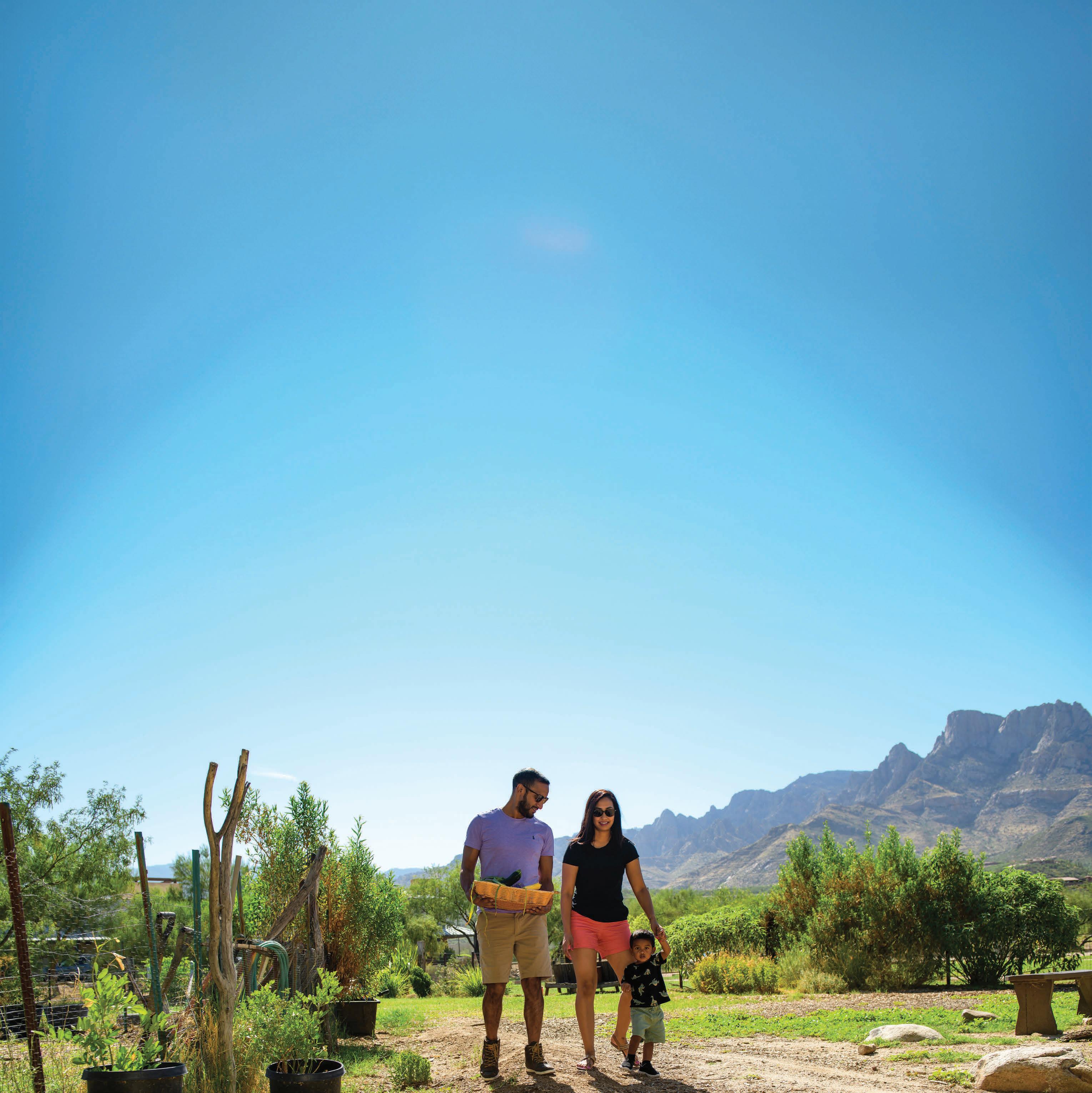


TWO
THROUGH a





A MAN WALKS THROUGH the town in Orvieto, Italy on May 21. The streets of Orvieto are flanked by high buildings which provide shade to pedestrians.


A WOMAN PICKS UP a necklace at a jewelry stand during the Piazza del Popolo Market in Orvieto, Italy on May 23. The market featured a variety of goods including clothing and fresh foods.

BY MELISA GUZELOGLU
The University of Arizona volleyball team closed out the 2023-2024 season with an 8-23 (3-17 Pac-12) overall record. The Wildcats look ahead to improve and move forward this year in a new conference having recently joined the Big 12.
Arizona will be playing teams including BYU, Baylor University and the University of Kansas this season. The winners of the Big 12 volleyball title, the University of Texas at Austin, left for the Southeastern Conference.
The Wildcats will have a chance to open strong as they look to utilize new and returning players while dealing with tough Wildcat departures like outside hitter Sofia
Maldonado Diaz.
The Wildcats have already gotten a chance to play, having competed against the University of Northern Colorado in an exhibition match on Aug. 24, which Arizona won 3-1. Despite the loss of some key players from last season like Diaz, Arizona quickly took off in the game, winning every set but the first (19-25, 25-19, 25-20, 25-21).
The Wildcats have brought back returning players, including four starters from the 2023 season. Some of these players include Ana Heath, who led the 2023 season with 1,037 assists, fifth year Jaelyn Hodge who totaled 309 kills last season, Jordan Wilson and Alayna Johnson. Arizona also welcomed freshman outside hitter Carlie Cisneros, who came in as the nation’s No. 1 recruit.

Cisneros recorded seven kills and led Arizona with nine digs during the exhibition match against Northern Colorado. As the Wildcats come off a strong opening in their exhibition match, Arizona will be taking on some notable opponents by the time Big 12 play rolls around.
Season at a glance: Arizona will kick off the season hosting the Cactus Classic by welcoming Boise State University, Tennessee State University and Virginia Commonwealth University in McKale Center starting Friday, Aug. 30 and ending Sept. 1. The first match will be
against Boise State when the Broncos face the Wildcats on Friday, Aug. 30, at 6 p.m. Arizona will then take on VCU at 12:30 p.m. on Saturday, Aug. 31. Ending the Cactus Classic, Arizona will go against Tennessee State on Sunday, Sept. 1, at 12:30 p.m.
Arizona’s Big 12 play will begin when the Wildcats travel to meet Baylor on Sept. 25, after which Arizona will take another short trip to see TCU on Sept. 27.
The Wildcats have their first Big 12 conference home match on Oct. 2 against BYU and play the University of Utah on Oct. 4, both in McKale Center. Arizona will then head to Tempe, meeting ASU on Oct. 9, before hosting three home games against the University of Colorado Boulder on Oct. 16, the University of Houston on Oct. 18 and
BY GRACE CARNAL
The Arizona Wildcats are entering the 20242025 season ready to make a name for themselves in the Big 12. Their record last season was 6-8-5 (3-6-2 in the Pac-12.) This season, as part of a new conference, the Wildcats will be traveling to the East Coast to play the best of the best. The Wildcats have already been picked 10th in the Big 12 preseason poll.
Arizona has 22 returning players and has added 10 new freshmen and two transfers. The Wildcats have already played four games and won two, keeping a 2-1-1 early record.
Fifth year Nicole Dallin was awarded Big 12 offensive player of the week, making her the first Wildcat to win an award in this new conference.
Dallin was also named TopDrawerSoccer’s Player of the Week.
Dallin, Megan Chelf and Sarah Rice will be
returning for their fifth year granted to them as a result of the COVID-19 pandemic.
The Wildcats have some experience playing Big 12 teams in the past under head coach Becca Moros, despite being in a different conference before this year.
Two new assistant coaches were added to the Wildcats’ coaching staff this summer: Philip Congleton and Nathaniel Gonzalez, who are replacing Lorraine Quinn and Brian Periman.
The Arizona women’s soccer team thrives on aggressive, fastpaced offense, using quick transitions and sharp passing to create scoring chances. They have been showing off their talent early on, winning their first two games by more than two goals. Seven different players on the team have already scored goals in the past four games, including Dallin with five on the season.
Defense:
The Wildcats’ defense this year is
about organization and effort. To stop attacks, a high defensive line is used to block space. Their well-organized defense and effective communication help close off passing lanes and stop scoring chances.
The Wildcats use pressure to force errors and are aggressive in their pursuit of victory in individual games. By tracking back and protecting the defense, defensive midfielders help to keep the team compact and difficult to break down.
ASU on Oct. 24.
During the month of November, Arizona will play through the tail end of its conference schedule hosting both Kansas State University on Nov. 6 and the University of Kansas on Nov. 8, playing in McKale Center. The Wildcats will then travel for three straight road games as they visit the University of Cincinnati on Nov. 14, West Virginia University on Nov. 17 and Colorado on Nov. 21.
Arizona will return to McKale Center to play its last two regular season home games. The Wildcats will play Iowa State University on Nov. 23 and the University of Central Florida on Nov. 27. The final Big 12 game of the regular season will have Arizona traveling to Lubbock, Texas, as the Wildcats take on Texas Tech University on Nov. 29.
